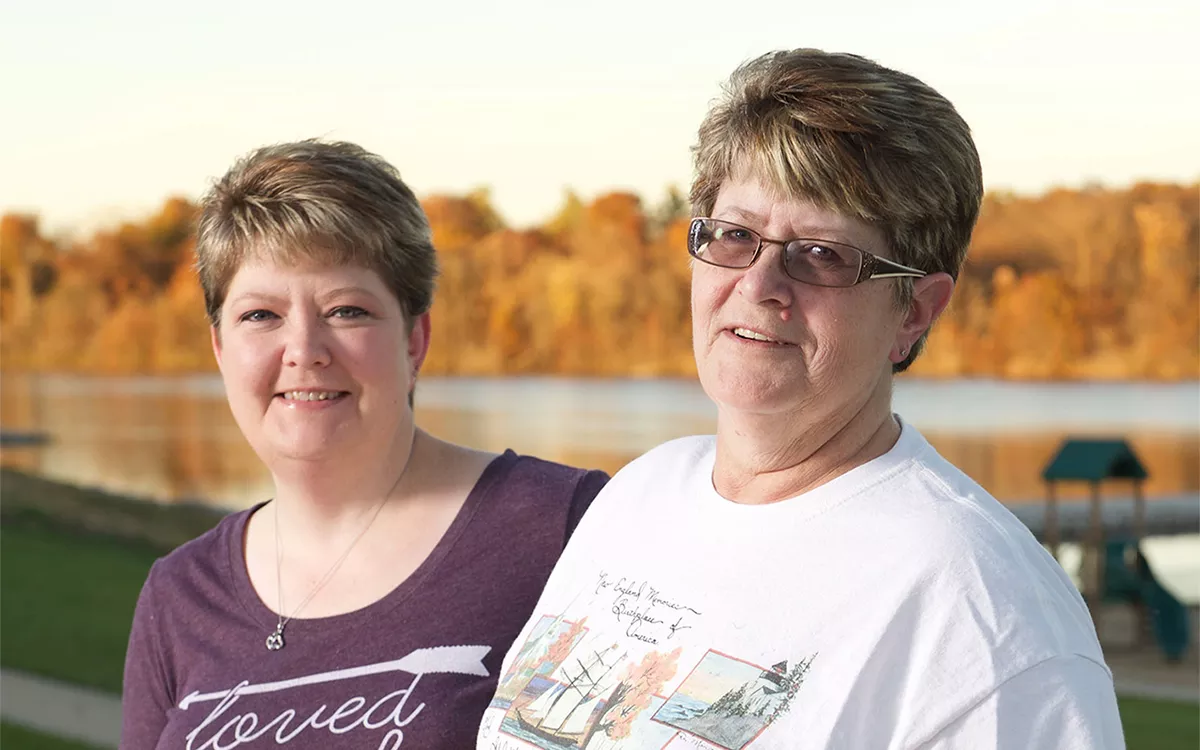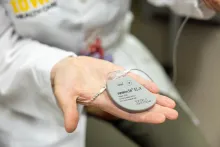UI Cardiovascular Genetics Program identifies cause of family’s rare form of heart disease

It started out as an ordinary night in 2008. Terri Essary of Brighton, Iowa, was lying down for bed when suddenly she found it very hard to breathe.
With a family history of heart failure and sudden cardiac death, Terri didn’t take any chances.
“I told my husband I need to go to the hospital,” she says.
Terri and her spouse, Larry, rushed to the nearest hospital in Washington, Iowa. Terri’s blood pressure was very high and she was retaining fluid—two common symptoms often related to heart problems.
Due to the uncertainty surrounding her symptoms, Terri was transferred to University of Iowa Hospitals & Clinics, where heart failure specialists determined that Terri had a condition called left ventricular non-compaction (LVNC), a problem that occurs during the development of the heart.
A normal adult heart has a solid area on the outside and a trabeculated (strands of intertwined muscle tissue) area on the inside. The solid area on the outside typically is much thicker than the trabeculated area on the inside.
Barry London, MD, PhD, a UI Heart and Vascular Center cardiologist who specializes in cardiovascular genetic disorders, describes the appearance of the trabeculated area as “strandy.”
“Normally as the heart develops the trabeculated area becomes solid until the walls of the heart get thick. However, in people with LVNC, this process doesn’t happen,” London says. “The solid area on the outside of the heart is very thin, while the trabeculated area continues to grow, appearing spongy on an ultrasound of the heart.”
As a result, the heart becomes weak over time and doesn’t pump efficiently. In extreme cases, LVNC can cause sudden cardiac death.
Terri was put on medication to prevent her heart from becoming weaker. Five years later, in 2013, she experienced extreme swelling in her legs and gained a lot of water weight. Feeling miserable and unsure what to do, she returned to UI Heart and Vascular Center, this time with her daughter, Sheri Garmoe, who also had been diagnosed and was receiving treatment for LVNC.
After a series of tests and discussions with UI Heart and Vascular cardiologists about their family history of heart disease and sudden cardiac death, Terri and Sheri were told they would be good candidates for a genetic family study. They met with London, who noted that most cases of LVNC are caused by a mutation in one of the genes that control the structural development of the heart.
There is a 50/50 chance a parent with the mutated gene will be pass it on to their children, but not everyone with LVNC will have heart problems. It’s only a problem if the condition causes a weak heart, irregular heart rhythms, a stroke, or other heart-related issues, London notes.
“Because this is a genetic disease, it’s important to screen the family to identify who has a weak heart and who needs to be treated,” London says.
Staff from the UI Cardiovascular Genetics Program obtained medical records and blood samples from 20 of Terri and Sheri’s adult family members. ECGs (electrocardiograms, also referred to as EKGs), echocardiograms, and MRIs also were performed, and eight members of the family were found to have LVNC.
Sheri was the first family member to have the genetic testing done, and she was found to carry a genetic mutation.
“Most of us were so willing to participate in the family study because we want our disease to be understood,” Sheri says. “We want to help other families so they don’t have to go through all of this.”
With the help of Becky Gutmann, nurse manager of the UI Cardiovascular Genetics Program and clinical research specialist, 47 members of Terri and Sheri’s family have now enrolled in the study.
For each family member affected by LVNC, UI Cardiovascular Genetics Program staff can discuss what the disease means for them and their family.
Terri and other members of her family felt relief after discovering more about their genetic disease.
“Now we have a ‘why’,” Terri says. “Before, we didn’t know why members of our family had heart disease or why members of our family who seemed completely normal were suddenly falling over dead.”
Today, treatment for both Terri and Sheri includes medication and an implantable cardioverter defibrillator (ICD). The pacemaker function of the ICD monitors and stimulates the heart if it is beating too slowly. If an abnormal or life-threatening rhythm occurs, the device sends a shock to “reset” the heartbeat.
It’s also important for Terri, Sheri, and the rest of their family to keep moving. Sheri loves Zumba and now takes extra cardiac classes.
“We can’t become sedentary,” Sheri says. “The heavier you are, the harder your heart has to work, so it’s important we stay healthy.”
Terri and Sheri believe their quality of life has improved since discovering their disease. Both say they are doing more now than ever before.
“I have total faith in UI Hospitals & Clinics, and we’re very lucky to have them,” Terri says.
The UI Cardiovascular Genetics Program is the only integrated consultative service of its kind in the region and one of only a few in the United States that provides clinical evaluation, genetic counseling and testing, and management recommendations for patients with inherited cardiovascular disorders and their families, notes Ferhaan Ahmad, MD, PhD, director of the program.
“The program also includes internationally recognized investigators who help apply the latest discoveries in cardiovascular genetics research to the care of patients and families,” Ahmad says.
— Emily Elliott
Winter 2016
Patient Stories

